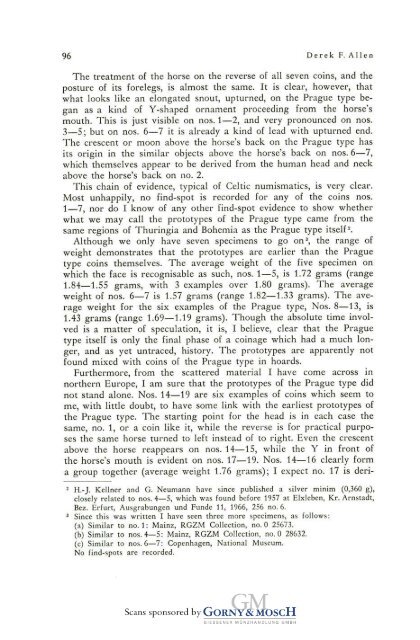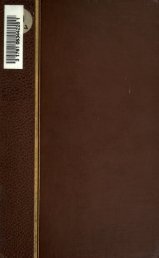jahrbuch numismatik geldgeschichte - Medievalcoinage.com
jahrbuch numismatik geldgeschichte - Medievalcoinage.com
jahrbuch numismatik geldgeschichte - Medievalcoinage.com
Erfolgreiche ePaper selbst erstellen
Machen Sie aus Ihren PDF Publikationen ein blätterbares Flipbook mit unserer einzigartigen Google optimierten e-Paper Software.
96 Derek F. Allen<br />
The treatment of the horse on the reverse of all seven coins, and the<br />
posture of its forelegs, is almost the same. It is clear, however, that<br />
what looks like an elongated snout, upturned, on the Prague type began<br />
as a kind of Y-shaped ornament proceeding from the horse's<br />
mouth. This is just visible on nos. 1-2, and very pronounced on nos.<br />
3-5; but on nos. 6-7 it is already a kind of lead with upturned end.<br />
The crescent or moon above the horse's back on the Prague type has<br />
its origin in the similar objects above the horse's back on nos. 6-7,<br />
which themselves appear to be derived from the human head and neck<br />
above the horse's back on no. 2.<br />
This chain of evidence, typical of Celtic numismatics, is very clear.<br />
Most unhappily, no find-spot is recorded for any of the coins nos.<br />
1-7, nor do I know of any other find-spot evidence to show whether<br />
what we may call the prototypes of the Prague type came from the<br />
same regions of Thuringia and Bohemia as the Prague type itself 2.<br />
Although we only have seven specimens to go an 3, the range of<br />
weight demonstrates that the prototypes are earlier than the Prague<br />
type coins themselves. The average weight of the five specimen on<br />
which the face is recognisable as such, nos. 1-5, is 1.72 grams (range<br />
1.84-1.55 grams, with 3 examples over 1.80 grams). The average<br />
weight of nos. 6-7 is 1.57 grams (range 1.82-1.33 grams). The average<br />
weight for the six examples of the Prague type, Nos. 8-13, is<br />
1.43 grams (range 1.69-1.19 grams). Though the absolute time involved<br />
is a matter of speculation, it is, I believe, clear that the Prague<br />
type itself is only the final phase of a coinage which had a much Tonger,<br />
and as yet untraced, history. The prototypes are apparently not<br />
found mixed with coins of the Prague type in hoards.<br />
Furthermore, from the scattered material I have <strong>com</strong>e across in<br />
northern Europe, I am sure that the prototypes of the Prague type did<br />
not stand alone. Nos. 14-19 are six examples of coins which seem to<br />
me, with little doubt, to have some link with the earliest prototypes of<br />
the Prague type. The starting point for the head is in each case the<br />
same, no. 1, or a coin like it, while the reverse is for practical purposes<br />
the same horse turned to lef t instead of to right. Even the crescent<br />
above the horse reappears on nos. 14-15, while the Y in front of<br />
the horse's mouth is evident on nos. 17-19. Nos. 14-16 clearly form<br />
a group together (average weight 1.76 grams); I expect no. 17 is deri-<br />
2 H.-J. Kellner and G. Neumann have since published a silver minim (0,360 g),<br />
closely related to nos. 4-5, which was found before 1957 at Elxleben, Kr. Arnstadt,<br />
Bez. Erfurt, Ausgrabungen und Funde 11, 1966, 256 no. 6.<br />
3 Since this was written I have seen three more specimens, as follows:<br />
(a) Similar to no. 1: Mainz, RGZM Collection, no. 0 25673.<br />
(b) Similar to nos. 4-5: Mainz, RGZM Collection, no. 0 28632.<br />
(c) Similar to nos. 6-7: Copenhagen, National Museum.<br />
No find-spots are recorded.

















